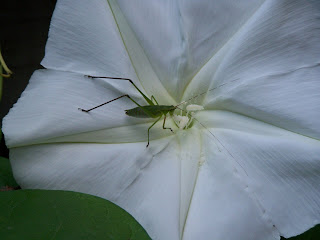Not a lot of blooms to show after a long hot dry summer.
Garlic chives always provide a nice white bloom late in the summer. It can be seen from quite a distance.
This is a little wild vine, probably in the morning glory family since it blooms in the morning. It has tiny flowers and the hummingbirds love them.
Sedum is always beautiful this time of year.
The moon flower has a visitor every evening. He works and works on cleaning the stamin.
This picture was taken a couple of weeks ago. No sign of catepillar's on the parsley today. We plant lots of parsley for them to eat.
Mums help with the color. Thanks to the box store.
Still have butterfly bush blooming.
Time to harvest some seeds from the butterfly weed and
and parsley.
Thursday, September 15, 2011
Thursday, September 8, 2011
Inspection Day
Finally the temp is reasonable and no storms so we went to our friend Aggie's to look at her bee hive.
There are two hive bodies and one super. The super is where you hope the honey bees will store their honey. The hive bodies is where you hope they will raise their brood.
Opening the super we could spot honey right away. Notice the frames are smaller than the ones you will see later from the hive body. All the white cells are full of honey and capped.
The girls have been busy. Aggie has beautiful flower and veggie gardens and these bees made good use of them.
As we lifted the frames the honey would drip out and the bees quickly converged to eat it.
Below the super is the top hive body and you can see the bees were filling all the space. The big mound on top is where they built comb and put honey. Bees will fill whatever space is available.
Now we know there is enough honey to harvest.
We left Aggie's and went home to look at our two hives. Last spring we lost our bees and bought two nucs to replace them. The green hive was refilled with a small nuc. We opened it first to check the top hive body (we do not have supers on these hives because the bees need to build out the frames and raise brood.)
The frames had bees on them but they have not build out the comb and they are empty.
So next we checked in the bottom hive body. The brown colored capped comb is where the brood resides. These are larvae cells that have been capped with a wax cover. The pattern of tight, compact cells is a healthy sign. They are slightly convex and there is an occasional cell that is not yet capped. All this is a sign of a strong queen.
Next we opened the yellow hive which has a larger, stronger colony. The top hive body had honey. The capped honey is white and the cap is flat. Seems that these girls have had better luck with the honey. We did not go into the bottom hive body but it looked like it had brood.
Next, we plan to extract honey from Aggie's hive.
Stay tuned.
There are two hive bodies and one super. The super is where you hope the honey bees will store their honey. The hive bodies is where you hope they will raise their brood.
Opening the super we could spot honey right away. Notice the frames are smaller than the ones you will see later from the hive body. All the white cells are full of honey and capped.
The girls have been busy. Aggie has beautiful flower and veggie gardens and these bees made good use of them.
As we lifted the frames the honey would drip out and the bees quickly converged to eat it.
Below the super is the top hive body and you can see the bees were filling all the space. The big mound on top is where they built comb and put honey. Bees will fill whatever space is available.
Now we know there is enough honey to harvest.
We left Aggie's and went home to look at our two hives. Last spring we lost our bees and bought two nucs to replace them. The green hive was refilled with a small nuc. We opened it first to check the top hive body (we do not have supers on these hives because the bees need to build out the frames and raise brood.)
The frames had bees on them but they have not build out the comb and they are empty.
So next we checked in the bottom hive body. The brown colored capped comb is where the brood resides. These are larvae cells that have been capped with a wax cover. The pattern of tight, compact cells is a healthy sign. They are slightly convex and there is an occasional cell that is not yet capped. All this is a sign of a strong queen.
Next we opened the yellow hive which has a larger, stronger colony. The top hive body had honey. The capped honey is white and the cap is flat. Seems that these girls have had better luck with the honey. We did not go into the bottom hive body but it looked like it had brood.
Next, we plan to extract honey from Aggie's hive.
Stay tuned.
Subscribe to:
Comments (Atom)














